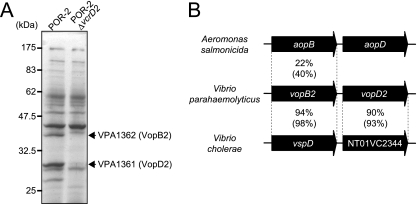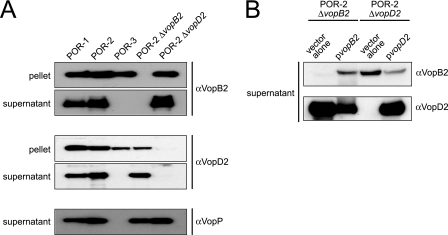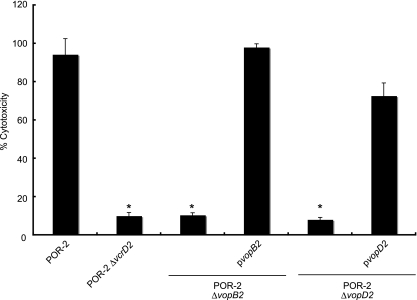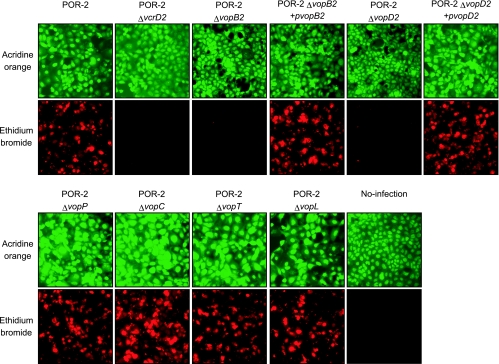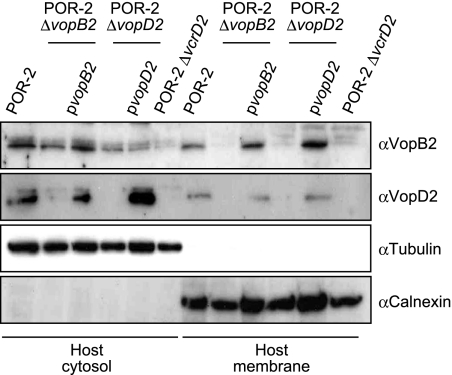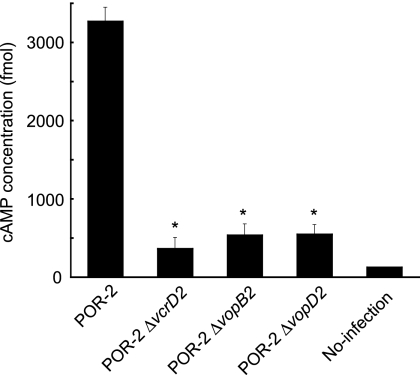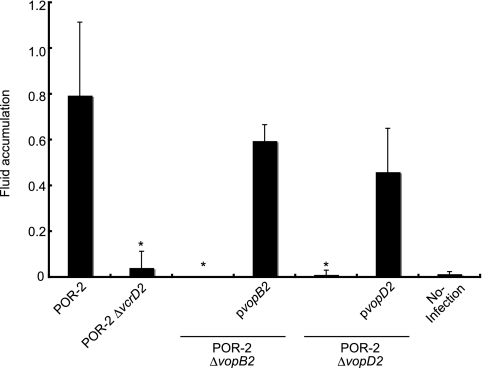Abstract
The type III secretion system (T3SS) translocon complex is composed of several associated proteins, which form a translocation channel through the host cell plasma membrane. These proteins are key molecules that are involved in the pathogenicity of many T3SS-positive bacteria, because they are necessary to deliver effector proteins into host cells. A T3SS designated T3SS2 of Vibrio parahaemolyticus is thought to be related to the enterotoxicity of this bacterium in humans, but the effector translocation mechanism of T3SS2 is unclear because there is only one gene (the VPA1362 gene) in the T3SS2 region that is homologous to other translocon protein genes. It is also not known whether the VPA1362 protein is functional in the translocon of T3SS2 or whether it is sufficient to form the translocation channel of T3SS2. In this study, we identified both VPA1362 (designated VopB2) and VPA1361 (designated VopD2) as T3SS2-dependent secretion proteins. Functional analysis of these proteins showed that they are essential for T3SS2-dependent cytotoxicity, for the translocation of one of the T3SS2 effector proteins (VopT), and for the contact-dependent activity of pore formation in infected cells in vitro. Their targeting to the host cell membrane depends on T3SS2, and furthermore, they are necessary for T3SS2-dependent enterotoxicity in vivo. These results indicate that VopB2 and VopD2 act as translocon proteins of V. parahaemolyticus T3SS2 and hence have a critical role in the T3SS2-dependent enterotoxicity of this bacterium.
Vibrio parahaemolyticus is a gram-negative marine bacterium that causes acute gastroenteritis in humans, the main symptoms of which are diarrhea and abdominal pain (1, 5, 13, 15, 19, 26). Most V. parahaemolyticus strains isolated from patients with diarrhea produce thermostable direct hemolysin (TDH) (15, 35, 37). Purified TDH has a number of biological effects, including erythrocyte lysis, cardiotoxicity, induction of chloride ion secretion, and induction of fluid accumulation in the ileal loop model (8, 14-16, 27, 33, 36, 38-40). Therefore, TDH is considered an important virulence factor for this bacterium. However, it has been reported that a mutant strain with both copies of tdh deleted, which completely abolished the hemolytic activity, still showed fluid accumulation in the rabbit intestine, suggesting that an unknown virulence factor(s) may be involved in the enterotoxicity caused by TDH-producing V. parahaemolyticus (31).
Whole-genome sequencing of V. parahaemolyticus strain RIMD2210633 revealed the presence of two sets of genes on chromosomes 1 and 2 encoding two distinct type III secretion systems (T3SS), which are designated T3SS1 and T3SS2, respectively (23). The T3SS1 gene cluster is found in TDH-positive and -negative strains, and although there are some exceptions, the T3SS2 gene cluster is highly associated with TDH-positive strains (18, 24, 32). A functional analysis of T3SS2 revealed that it is associated with the cytotoxic activity against Caco-2 cells observed in vitro (21, 31, 32). Furthermore, the enterotoxicity observed for a tdh deletion mutant strain was not observed for a T3SS2-deficient mutant strain (32). Therefore, T3SS2 is also thought to be related to the enterotoxicity of V. parahaemolyticus in humans.
Recently, some effector proteins secreted by T3SS2 have been identified. VopA/P shares ∼55% similarity with the YopJ-like proteins from Yersinia and Salmonella, and it inhibits mitogen-activated protein kinase signaling but not the NFκB pathway in mammalian cells (21, 23, 32, 42). VopA/P (VPA1346) is an acetyltransferase that inhibits ATP binding by acetylating the catalytic loop of mitogen-activated protein kinase kinases (41). VopT (VPA1327) has ADP-ribosyltransferase activity and is partially involved in the T3SS2-dependent cytotoxicity observed with Caco-2 cells (21). VopL (VPA1370), which has three Wiskott-Aldrich homology 2 domains, induces formation of actin stress fibers and enhances actin filament assembly without eukaryotic factors (22). VopC (VPA1321) is homologous to Escherichia coli cytotoxic necrotizing factor (38% identity) (21). However, whether these factors are involved in T3SS2-dependent enterotoxicity has been unclear.
Many gram-negative bacteria known to be pathogenic for plants or animals use a specialized T3SS to inject effector proteins directly into the host cells (17). The translocation of effector proteins across the eukaryotic host cell membrane is mediated by a bacterial translocon (4). The T3SS translocon is composed of several proteins associated in a complex that forms a translocation channel through the host cell plasma membrane. These proteins are key molecules that are involved in the pathogenicity of many T3SS-positive bacteria, because they are necessary for delivering effector proteins into host cells. Despite the critical role of translocons in T3SS function, there is only one open reading frame that has been predicted to encode a translocon homolog (designated VPA1362) in the T3SS2 region of V. parahaemolyticus (23). The non-O1, non-O139 Vibrio cholerae AM-19226 strain, which can cause gastroenteritis in humans, also carries functional T3SS genes, which are related to the T3SS2 genes of V. parahaemolyticus, but there is only one open reading frame that has been predicted to encode a translocon homolog in the T3SS region of this organism (6). Therefore, the detailed mechanisms of effector translocation by T3SS2 of V. parahaemolyticus and by the T3SS2-related T3SS of V. cholerae are largely unknown.
In this study, we identified not only VPA1362 (designated VopB2) but also VPA1361 (designated VopD2) as T3SS2-dependent secretion proteins. Functional analysis of these two proteins revealed that they act as T3SS2 translocon proteins and are essential for T3SS2-dependent biological activities, such as cytotoxicity and enterotoxicity.
MATERIALS AND METHODS
Bacterial strains and plasmids.
V. parahaemolyticus strain RIMD2210633 (KP positive, serotype O3:K6) (23) was used for construction of deletion mutants and functional studies. E. coli DH5α and SM10λpir (25) were used for general manipulation of plasmids and for mobilization of plasmids into V. parahaemolyticus. Strains and plasmids used in this study are listed in Table 1.
TABLE 1.
Strains and plasmids used in this study
| Strain or plasmid | Description | Reference |
|---|---|---|
| V. parahaemolyticus strains | ||
| KXV237 | RIMD2210633 (KP positive, serotype O3:K6) | 23 |
| POR-1 | ΔtdhAS derivative of KXV237 | 31 |
| POR-2 | POR-1 T3SS1 knockout of vcrD1 gene | 32 |
| POR-3 | POR-1 T3SS2 knockout of vcrD2 gene | 32 |
| POR-2 ΔvcrD2 | POR-1 T3SS1/2 knockout of vcrD1 and vcrD2 genes | 21 |
| POR-2 ΔvopB2 | POR-2 knockout of vopB2 (VPA1362) gene | This study |
| POR-2 ΔvopD2 | POR-2 knockout of vopD2 (VPA1361) gene | This study |
| POR-2 ΔvopP | POR-2 knockout of vopP (VPA1346) gene | 21 |
| POR-2 ΔvopC | POR-2 knockout of vopP (VPA1321) gene | 21 |
| POR-2 ΔvopT | POR-2 knockout of vopP (VPA1327) gene | 21 |
| POR-2 ΔvopL | POR-2 knockout of vopL (VPA1370) gene | This study |
| Plasmids | ||
| pYAK1 | R6K-ori suicide vector containing sacB gene | 21 |
| pYAK1-ΔvopB2 | Derivative of suicide vector pYAK1 for generating the vopB2 deletion mutants | This study |
| pYAK1-ΔvopD2 | Derivative of suicide vector pYAK1 for generating the vopD2 deletion mutants | This study |
| pYAK1-ΔvopL | Derivative of suicide vector pYAK1 for generating the vopL deletion mutants | This study |
| pSA19CP-MCS | Complementation vector for V. parahaemolyticus, Cmr | 29 |
| pSA19Cm-ONO | pSA19CP-MCS containing cyaA (bp 4 to 1216) | 30 |
| pSA-vopT-cyaA | Derivative of pSA19Cm-ONO, encoding a fusion of VopT (bp 1 to 195) with CyaA (bp 4 to 1216) at C terminus | 21 |
| pSA-tdhP | pSA19CP-MCS containing tdhA promoter in EcoRI-SmaI site | This study |
| pvopB2 | Derivative of pSA-tdhP, containing vopB2 | This study |
| pvopD2 | Derivative of pSA-tdhP, containing vopD2 | This study |
Analysis of secreted proteins.
Secreted proteins were prepared as described previously (21). Briefly, bacterial strains were grown for 6 h in LB medium supplemented with 0.5% NaCl. Secreted proteins were harvested by precipitation with cold trichloroacetic acid at a final concentration of 10% (vol/vol) on ice for 60 min, followed by centrifugation at 48,000 × g for 60 min. The pellets were rinsed in cold 100% acetone and solubilized in Laemmli buffer.
Immunoblot analysis.
Samples used for Western blot analysis were separated by sodium dodecyl sulfate-polyacrylamide gel electrophoresis (SDS-PAGE) (12% polyacrylamide). Transferred membranes were probed with anti-VopB2, anti-VopD2, or anti-VopP polyclonal antibodies (32) and then probed with horseradish peroxidase-conjugated goat anti-rabbit antibody (Zymed). The blots were developed by using an ECL Western blotting kit (Amersham).
Cytotoxicity assays.
The cytotoxicity assays were performed as described previously (21). Briefly, eukaryotic cells were cocultured for 6 h with phosphate-buffered saline-washed bacteria at a multiplicity of infection (MOI) of 10. The release of lactate dehydrogenase (LDH) into the medium was quantified using CytoTox96, a nonradioactive cytotoxicity kit (Promega), according to the manufacturer's instructions. The LDH release (percent cytotoxicity) was calculated using the following equation: (optical density at 490 nm [OD490] for experimental release − OD490 for spontaneous release)/(OD490 for maximum release − OD490 for spontaneous release) × 100. The spontaneous release was the amount of LDH released from the cytoplasm of uninfected cells, whereas the maximum release was the amount of LDH released by total lysis of uninfected cells.
Adenylate cyclase reporter gene.
Caco-2 cells were infected with V. parahaemolyticus harboring a pSA-VopT-CyaA plasmid at an MOI of 10 for 6 h. After infection, the cyclic AMP (cAMP) levels in infected cells were determined using a cAMP Biotrak EIA kit (Amersham Biosciences) according to the manufacturer's instructions.
T3SS-dependent pore formation assay.
The T3SS-dependent permeability assay was performed as described previously (34). Briefly, Caco-2 cells were infected with V. parahaemolyticus for 2 h at an MOI of 100, which was followed by exposure to 25 μg/ml ethidium bromide and 5 μg/ml acridine orange.
Fractionation of infected host cells.
Fractionation of infected host cells was performed as described previously (10, 11, 20). Briefly, Caco-2 cells were infected with V. parahaemolyticus for 3 h at an MOI of 10. Infected cells were washed with ice-cold phosphate-buffered saline and then suspended in homogenization buffer (3 mM imidazole, 250 mM sucrose, 0.5 mM EDTA; pH 7.4) supplemented with protease inhibitor cocktail (Sigma) and mechanically disrupted by passage through a 22-gauge needle. The homogenate was centrifuged at 3,000 × g for 15 min to pellet unbroken cells, bacteria, nuclei, and cytoskeletal components. The supernatant was subjected to ultracentrifugation at 41,000 × g for 20 min to separate the host cell membrane (pellet) from the cytoplasm (supernatant).
Rabbit ileal loop test.
Rabbit ileal loop tests were performed as previously described (31, 32). The bacteria tested (109 CFU) were suspended in 1 ml LB broth with 0.5% NaCl and injected into ligated ileal loops of rabbits, and then the fluid accumulation in each loop was measured 15 h after challenge. The fluid accumulation was expressed as the amount of accumulated fluid (in milliliters) per centimeter of ligated rabbit small intestine.
Statistical analysis.
All data were expressed as means and standard deviations of three determinations per experimental condition. The statistical significance was determined by a one-way analysis of variance, followed by Dunnett's multiple-comparison test. A P value of <0.05 was considered statistically significant.
RESULTS AND DISCUSSION
Identification of T3SS2-dependent secreted proteins.
Although type III secretion is generally considered to be contact dependent, V. parahaemolyticus can secrete T3SS-dependent secreted proteins (translocons and effectors) into culture medium (32). Therefore, to identify T3SS2-dependent secreted proteins, supernatants from cultures of POR-2, which is a strain with an inactivated T3SS1 apparatus, and POR-2 ΔvcrD2, which is a strain deficient in both T3SS1 and T3SS2, were separated by SDS-PAGE (Fig. 1A). Most bands were obtained for both strains, but three abundant proteins with molecular masses of approximately 40, 30, and 27 kDa were found to be unique to the POR-2 strain. Analysis of their N-terminal amino acid sequences revealed that two of these three proteins, VPA1362 (40-kDa band) and VPA1361 (30-kDa band), are encoded in tandem in the T3SS2 region. VPA1362 showed a high degree of identity (94%) to the predicted secreted protein VspD from non-O1, non-O139 V. cholerae AM-19226 (6) and 22% identity with Aeromonas salmonicida subsp. salmonicida A449 AopB protein (Fig. 1B). It has been reported that AopB has 42% identity with Yersinia enterocolitica translocon protein YopB and is predicted to be involved in the translocation function of the A. salmonicida subsp. salmonicida T3SS (2, 3, 12, 28). VPA1362 also shows weak sequence similarity to EspD from enteropathogenic E. coli (27% identity and 44% positive), which is one of the translocon proteins of the locus of enterocyte effacement-encoded T3SS (7, 9). By contrast, VPA1361 did not show any motif or sequence homology with known proteins, except for the conserved hypothetical protein NT01VC2344, which is encoded adjacent to VspD in the T3SS gene cluster of non-O1, non-O139 V. cholerae AM-19226 (6). In many cases, translocon-associated proteins are encoded in tandem in the T3SS region and are secreted abundantly in culture supernatants under suitable conditions. We designated the VPA1362 and VPA1361 proteins VopB2 and VopD2, respectively, and their possible role as translocons was examined in the experiments described below. The 27-kDa protein, which is secreted in a T3SS2-dependent manner, was also detected in the supernatants from the POR-2 ΔvopB2 and POR-2 ΔvopD2 strains and was not recognized by anti-VopB2 or anti-VopD2 antibodies (data not shown). Therefore, we considered this protein a T3SS2-dependent secreted protein distinct from VopB2 and VopD2.
FIG. 1.
Proteomic analysis of T3SS2-dependent secreted proteins. (A) SDS-PAGE of total secreted proteins from the POR-2 and POR-2 ΔvcrD2 strains. The gel was stained with Coomassie brilliant blue G-250. Protein bands that were excised and analyzed by N-terminal amino acid sequencing are indicated by arrows. The positions of molecular weight markers are indicated on the left. (B) Genomic organization of the VPA1362 (VopB2) and VPA1361 (VopD2) genes and sequence identities and similarities of the proteins with other putative T3SS translocon proteins.
VopB2 and VopD2 are specifically secreted via T3SS2.
V. parahaemolyticus strain RIMD2210633 possesses sets of genes for two T3SS, both of which are able to secrete proteins but which recognize distinct proteins (23, 32). Western blot analysis was used to determine whether VopB2 and VopD2 are secreted only by T3SS2 or also by T3SS1. As shown in Fig. 2A, both proteins were specifically secreted by T3SS2. Both protein bands were absent when either a vopB2 or vopD2 deletion mutant (POR-2 ΔvopB2 or POR-2 ΔvopD2) was examined, but deletion of either gene did not influence the secretion of VopP, which is another protein secreted by T3SS2 (32), and deletion of one gene did not affect secretion of the product of the other gene. The production of the proteins in supernatants of strains POR-2 ΔvopB2 and POR-2 ΔvopD2 was fully restored by in trans complementation with the vopB2 and vopD2 genes, respectively (Fig. 2B). These results indicate that VopB2 and VopD2 seem to be T3SS2-specific substrates and are not required for T3SS2 secretion.
FIG. 2.
VopB2 and VopD2 are specifically secreted via T3SS2. (A) Western blot analysis of bacterial pellets and supernatants of isogenic POR-1 strains. The lanes contained POR-1 (tdhAS deletion mutant) (lane 1), POR-2 (vcrD1 deletion mutant) (lane 2), POR-3 (vcrD2 deletion mutant) (lane 3), POR-2 ΔvopB2 (vcrD1 vopB2 mutant) (lane 4), and POR-2 ΔvopD2 (vcrD1 vopD2 mutant) (lane 5). Blots were probed with anti-VopB2 (αVopB2) (top), anti-VopD2 (αVopD2) (middle), and anti-VopP (αVopP) (bottom) antibodies. (B) Western blot analysis of supernatants of the POR-2 ΔvopB2 and POR-2 ΔvopD2 strains expressing VopB2 or VopD2. Blots were probed with anti-VopB2 (top) and anti-VopD2 (bottom) antibodies.
VopB2 and VopD2 are necessary for T3SS2-dependent cytotoxicity.
We have reported previously that one of the characteristic effects of T3SS2 is cytotoxicity to Caco-2 cells in vitro (21). Therefore, we tried to determine whether VopB2 and VopD2 are involved in this cytotoxicity. The cytotoxic activity of the POR-2 ΔvopB2 and POR-2 ΔvopD2 strains in infected cells was dramatically decreased to a level similar to that in cells infected with the POR-2 ΔvcrD2 strain (T3SS1 and T3SS2 deficient) (Fig. 3). The cytotoxicity of the POR-2 ΔvopB2 and POR-2 ΔvopD2 strains was fully restored by in trans complementation with the vopB2 and vopD2 genes, respectively. These results indicated that VopB2 and VopD2 are necessary for T3SS2-dependent cytotoxicity.
FIG. 3.
VopB2 and VopD2 are necessary for T3SS2-dependent cytotoxicity. Caco-2 cells were infected for 6 h with V. parahaemolyticus mutant and complemented strains. Cytotoxicity was evaluated by determining the amount of LDH released. The error bars indicate standard deviations for the results of triplicate experiments. An asterisk indicates that the results are significantly different from the results obtained with the parent strain (P < 0.05).
VopB2 and VopD2 are necessary for T3SS2-dependent cell permeability.
Some T3SSs can form pores in the plasma membranes of host eukaryotic cells or synthetic lipid bilayers. This process is presumably mediated by translocons that are essential for effector translocation (4). Therefore, the pore-forming activity of T3SS2 with Caco-2 cells was evaluated by examining cellular uptake of two fluorescent molecules, ethidium bromide (red) and acridine orange (green). Acridine orange penetrates cells having an intact membrane, whereas ethidium bromide selectively enters cells having perforated membranes (34). As shown in Fig. 4, POR-2, a strain which is deficient in both TDH and the T3SS1 apparatus genes, exhibited extensive pore-forming activity with the Caco-2 cells, whereas no pore-forming activity was seen with either POR-2 ΔvcrD2 or the noninfected control. Similar to infection of cells with POR-2 ΔvcrD2, infection of Caco-2 cells with the POR-2 ΔvopB2 and POR-2 ΔvopD2 strains did not induce any detectable ethidium bromide uptake. The pore-forming activity of the POR-2 ΔvopB2 and POR-2 ΔvopD2 strains was fully restored by in trans complementation with the vopB2 and vopD2 genes, respectively. Furthermore, the pore-forming activity of VopB2 and VopD2 was also confirmed by infection with T3SS2 effector deletion mutant strains, such as POR-2 ΔvopP, POR-2 ΔvopC, POR-2 ΔvopT, and POR-2 ΔvopL, indicating that none of the known T3SS2 effectors is involved in the pore-forming process. To exclude the possibility that this phenomenon was caused by membrane disruption due to cytotoxic activity of the strains, the levels of LDH in the supernatants were also determined. The low levels of LDH released from cells exposed to each of the V. parahaemolyticus strains indicated that no extensive cell disruption occurred during the period investigated (data not shown). Taken together, these results suggest that T3SS2 exhibits pore-forming activity in the host cell membrane and that both VopB2 and VopD2 are necessary for this activity.
FIG. 4.
VopB2 and VopD2 are necessary for T3SS2-dependent cell permeability. Caco-2 cells were incubated with V. parahaemolyticus mutant strains for 2 h, and this was followed by exposure to acridine orange (green) and ethidium bromide (red).
VopB2 and VopD2 associated with the host cell membrane.
The association of VopB2 and VopD2 with the host cell membrane was then determined. Caco-2 cells infected with V. parahaemolyticus mutant strains were mechanically disrupted, and the postnuclear supernatant was fractionated into cytosolic (host cytosol) and membrane (host membrane) fractions. Each of the fractions was then analyzed by Western blotting with anti-VopB2 and anti-VopD2 antibodies (Fig. 5). Both VopB2 and VopD2 were detected in the host cell membrane fraction when cells were infected with the POR-2, POR-2 ΔvopB2(pvopB2), and POR-2 ΔvopD2(pvopD2) strains (Fig. 5, lanes 7, 9, and 11). No signal was detected in the host cell membrane fraction during infection of cells with the POR-2 ΔvopB2, POR-2 ΔvopD2, and POR-2 ΔvcrD2 strains (Fig. 5, lanes 8, 10, and 12). VopD2 could be translocated into the cytosol of host cells, but the translocation of VopB2 into host cytosol could not be determined because a nonspecific band was detected in this fraction. The host cytosolic protein β-tubulin was absent from the host membrane fractions, and the endoplasmic reticulum integral membrane protein calnexin was absent from the host cytosol fractions. These results indicated that both VopB2 and VopD2 are at least associated with the host cell membrane and that translocation requires a functional T3SS2 and both VopB2 and VopD2.
FIG. 5.
VopB2 and VopD2 localize to the host cell membrane. Caco-2 cells were infected with V. parahaemolyticus mutant strains for 3 h and subjected to subcellular fractionation by differential centrifugation. The fractions analyzed were the host cell cytosol (Host cytosol) and host cell membranes (Host membrane). The strains used were POR-2 (vcrD1 deletion mutant) (lanes 1 and 7), POR-2 ΔvopB2 (vcrD1 vopB2 mutant) (lanes 2 and 8), POR-2 ΔvopB2(pvopB2) (vcrD1 vopB2 strain expressing VopB2) (lanes 3 and 9), POR-2 ΔvopD2 (vcrD1 vopD2 mutant) (lanes 4 and 10), POR-2 ΔvopD2(pvopD2) (vcrD1 vopD2 strain expressing VopD2) (lanes 5 and 11), and POR-2 ΔvcrD2 (vcrD1 vcrD2 deletion mutant) (lanes 6 and 12). Blots were probed with anti-VopB2 (αVopB2), anti-VopD2 (αVopD2), antitubulin (αTubulin) (host cell cytosol marker), and anticalnexin (αCalnexin) (host cell membrane marker) antibodies.
VopB2 and VopD2 are necessary for translocation of T3SS2 effector protein.
To determine whether vopB2 and vopD2 are necessary for the translocation of VopT by T3SS2, pSA-vopT-cyaA, a plasmid expressing VopT C-terminally fused with the catalytic domain of Bordetella adenylate cyclase toxin, was transformed into V. parahaemolyticus strains (21). Caco-2 cells were infected with the resulting transformants, and the level of intracellular cAMP was determined by a specific enzyme-linked immunosorbent assay (Fig. 6). The level of intracellular cAMP induced in infected cells by the POR-2 strains expressing VopT-cyaA was higher than the detection limit of the assay, whereas the POR-2 ΔvopB2 and POR-2 ΔvopD2 strains induced low levels of cAMP production similar to the level induced by POR-2 ΔvcrD2, suggesting that vopB2 and vopD2 are necessary for translocation of the T3SS2 effector protein.
FIG. 6.
VopB2 and VopD2 are necessary for VopT translocation. Caco-2 cells were infected with V. parahaemolyticus mutant strains expressing VopT C-terminally fused with the catalytic domain of adenylate cyclase toxin, and the intracellular cAMP concentrations in infected cells were determined by an enzyme-linked immunosorbent assay. The error bars indicate the standard deviations for the results of triplicate experiments. An asterisk indicates that the results are significantly different from the results obtained with the parental strain (P < 0.01).
VopB2 and VopD2 are necessary for T3SS2-dependent enterotoxicity.
To investigate the contribution of vopB2 and vopD2 to the T3SS2-dependent enterotoxicity of V. parahaemolyticus, we examined the enterotoxic activity of vopB2 and vopD2 mutant strains in rabbit ileal loops. The POR-2 strain caused a high level of fluid accumulation (Fig. 7), in accordance with a previous report (32). The POR-2 ΔvopB2 and POR-2 ΔvopD2 strains induced little fluid accumulation, and the levels were similar to the levels induced by the POR-2 ΔvcrD2 strain and to noninfected control levels (negative control). The enterotoxicity of the POR-2 ΔvopB2 and POR-2 ΔvopD2 strains was fully restored by in trans complementation with the vopB2 and vopD2 genes, respectively. These results strongly indicate that vopB2 and vopD2 have a critical role in T3SS2-dependent enterotoxicity.
FIG. 7.
VopB2 and VopD2 are necessary for T3SS2-dependent enterotoxicity. The enterotoxic activities of V. parahaemolyticus mutant and complemented strains in rabbit ileal loops were examined. Fluid accumulation is the amount of fluid accumulated (in milliliters) per centimeter of ligated rabbit small intestine. The error bars indicate the standard deviations for the results of triplicate experiments. An asterisk indicates that the results are significantly different from the results obtained with the parental strain (P < 0.05).
In this study, we identified VopB2 (VPA1362) and VopD2 (VPA1361) as T3SS2-dependent secreted proteins. VopB2 was similar to the predicted translocon protein AopB from A. salmonicida subsp. salmonicida A449 and was weakly similar to EspD from enteropathogenic E. coli. EspD is well known as an locus of enterocyte effacement-encoded translocon protein (7, 9). Accordingly, it was expected that VopB2 would be a T3SS2 translocon-associated protein. By contrast, VopD2 did not show any motif or sequence homologies with any known protein except NT01VC2344, a conserved hypothetical protein of non-O1, non-O139 V. cholerae (6). Because VopB2 and VopD2 were secreted abundantly via T3SS2 under the conditions used and were encoded in tandem in the T3SS2 region, we tried to examine their possible roles in the translocon of T3SS2.
Several pieces of evidence supported the hypothesis that the two proteins that were identified in this study (VopB2 and VopD2) were functional as T3SS2 translocon-associated proteins. Both proteins were found to be (i) secreted specifically by the T3SS2 (Fig. 2); (ii) not necessary for T3SS2 effector secretion but necessary for effector translocation (Fig. 2A and 6); (iii) required for pore formation in host cell membranes (Fig. 4); (iv) localized to the host cell membrane (Fig. 5); and (v) essential for T3SS2-dependent biological activities, such as cytotoxicity in Caco-2 cells and enterotoxicity in a rabbit ileal loop model (Fig. 3 and 7).
The predicted structural features of VopB2 and VopD2 also support our hypothesis. Most translocon proteins reported so far contain one or two predicted transmembrane domains (4). The TM-PRED program (http://www.ch.embnet.org/cgi-bin/TMPRED form parser; 17 to 33 residues; scores, >1,000) predicts that VopB2 and VopD2 contain two transmembrane regions and one transmembrane region, respectively (in VopB2, amino acids 119 to 142 and 175 to 196; in VopD2, amino acids 99 to 118), supporting the idea that these proteins may function as translocons. Taken together, these findings strongly suggest that both VopB2 and VopD2 are functional T3SS2 translocon-associated proteins and are molecules that play a key role in the T3SS2-dependent enterotoxicity of V. parahaemolyticus.
The non-O1, non-O139 V. cholerae AM-19226 strain, which can cause gastroenteritis in humans, also carries functional T3SS genes, which are related to the T3SS2 genes of V. parahaemolyticus. The T3SS of AM-19226 is known to contribute to its virulence (6). The T3SS gene set of this strain contains a pair of genes that are highly similar to the VopB2 and VopD2 genes (Fig. 1B). In this regard, it is possible that not only VopB2 and VopD2 from V. parahaemolyticus but also the gene products from V. cholerae may be functional translocons of T3SS and may contribute to the virulence of these bacteria.
There are many things that are unclear regarding the detailed mechanism of action of T3SS2 of V. parahaemolyticus and the T3SS2-related T3SS gene cluster in non-O1, non-O139 V. cholerae, especially because there are a number of hypothetical genes in this region. Identification and functional analysis of proteins secreted by T3SS2 should lead to a better understanding of the pathogenic mechanisms not only of V. parahaemolyticus but also of non-O1, non-O139 V. cholerae. The results presented here for VopB2 and VopD2 could also increase our understanding of the pathogenic mechanism of non-O1, non-O139 V. cholerae.
Acknowledgments
This work was supported by the Research for the Future Program (grant 00L01411) of the Japanese Society for the Promotion of Science and by Grants-in-Aid for Scientific Research on Priority Areas and Scientific Research from the Ministry of Education, Culture, Sports, Science and Technology and from the Ministry of Health, Labor and Welfare, Japan.
Editor: J. B. Bliska
Footnotes
Published ahead of print on 9 June 2008.
REFERENCES
- 1.Blake, P. A., R. E. Weaver, and D. G. Hollis. 1980. Diseases of humans (other than cholera) caused by vibrios. Annu. Rev. Microbiol. 34341-367. [DOI] [PubMed] [Google Scholar]
- 2.Burr, S. E., K. Stuber, and J. Frey. 2003. The ADP-ribosylating toxin, AexT, from Aeromonas salmonicida subsp. salmonicida is translocated via a type III secretion pathway. J. Bacteriol. 1856583-6591. [DOI] [PMC free article] [PubMed] [Google Scholar]
- 3.Burr, S. E., T. Wahli, H. Segner, D. Pugovkin, and J. Frey. 2003. Association of type III secretion genes with virulence of Aeromonas salmonicida subsp. salmonicida. Dis. Aquat. Organ. 57167-171. [DOI] [PubMed] [Google Scholar]
- 4.Buttner, D., and U. Bonas. 2002. Port of entry-the type III secretion translocon. Trends Microbiol. 10186-192. [DOI] [PubMed] [Google Scholar]
- 5.Daniels, N. A., L. MacKinnon, R. Bishop, S. Altekruse, B. Ray, R. M. Hammond, S. Thompson, S. Wilson, N. H. Bean, P. M. Griffin, and L. Slutsker. 2000. Vibrio parahaemolyticus infections in the United States, 1973-1998. J. Infect. Dis. 1811661-1666. [DOI] [PubMed] [Google Scholar]
- 6.Dziejman, M., D. Serruto, V. C. Tam, D. Sturtevant, P. Diraphat, S. M. Faruque, M. H. Rahman, J. F. Heidelberg, J. Decker, L. Li, K. T. Montgomery, G. Grills, R. Kucherlapati, and J. J. Mekalanos. 2005. Genomic characterization of non-O1, non-O139 Vibrio cholerae reveals genes for a type III secretion system. Proc. Natl. Acad. Sci. USA 1023465-3470. [DOI] [PMC free article] [PubMed] [Google Scholar]
- 7.Elliott, S. J., L. A. Wainwright, T. K. McDaniel, K. G. Jarvis, Y. K. Deng, L. C. Lai, B. P. McNamara, M. S. Donnenberg, and J. B. Kaper. 1998. The complete sequence of the locus of enterocyte effacement (LEE) from enteropathogenic Escherichia coli E2348/69. Mol. Microbiol. 281-4. [DOI] [PubMed] [Google Scholar]
- 8.Fabbri, A., L. Falzano, C. Frank, G. Donelli, P. Matarrese, F. Raimondi, A. Fasano, and C. Fiorentini. 1999. Vibrio parahaemolyticus thermostable direct hemolysin modulates cytoskeletal organization and calcium homeostasis in intestinal cultured cells. Infect. Immun. 671139-1148. [DOI] [PMC free article] [PubMed] [Google Scholar]
- 9.Gartner, J. F., and M. A. Schmidt. 2004. Comparative analysis of locus of enterocyte effacement pathogenicity islands of atypical enteropathogenic Escherichia coli. Infect. Immun. 726722-6728. [DOI] [PMC free article] [PubMed] [Google Scholar]
- 10.Gauthier, A., M. de Grado, and B. B. Finlay. 2000. Mechanical fractionation reveals structural requirements for enteropathogenic Escherichia coli Tir insertion into host membranes. Infect. Immun. 684344-4348. [DOI] [PMC free article] [PubMed] [Google Scholar]
- 11.Gruenheid, S., I. Sekirov, N. A. Thomas, W. Deng, P. O'Donnell, D. Goode, Y. Li, E. A. Frey, N. F. Brown, P. Metalnikov, T. Pawson, K. Ashman, and B. B. Finlay. 2004. Identification and characterization of NleA, a non-LEE-encoded type III translocated virulence factor of enterohaemorrhagic Escherichia coli O157:H7. Mol. Microbiol. 511233-1249. [DOI] [PubMed] [Google Scholar]
- 12.Hakansson, S., K. Schesser, C. Persson, E. E. Galyov, R. Rosqvist, F. Homble, and H. Wolf-Watz. 1996. The YopB protein of Yersinia pseudotuberculosis is essential for the translocation of Yop effector proteins across the target cell plasma membrane and displays a contact-dependent membrane disrupting activity. EMBO J. 155812-5823. [PMC free article] [PubMed] [Google Scholar]
- 13.Hardy, W. G., and K. C. Klontz. 1996. The epidemiology of Vibrio infections in Florida. J. Infect. 1731176-1183. [DOI] [PubMed] [Google Scholar]
- 14.Honda, T., K. Goshima, Y. Takeda, Y. Sugino, and T. Miwatani. 1976. Demonstration of the cardiotoxicity of the thermostable direct hemolysin (lethal toxin) produced by Vibrio parahaemolyticus. Infect. Immun. 13163-171. [DOI] [PMC free article] [PubMed] [Google Scholar]
- 15.Honda, T., and T. Iida. 1993. The pathogenicity of Vibrio parahaemolyticus and the role of the thermostable direct haemolysin and related haemolysin. Rev. Med. Microbiol. 4106-113. [Google Scholar]
- 16.Honda, T., Y. Takeda, T. Miwatani, K. Kato, and Y. Nimura. 1976. Clinical features of patients suffering from food poisoning due to Vibrio parahaemolyticus—with special reference to changes in electrocardiograms. Kansenshogaku Zasshi 50216-223. (In Japanese.) [DOI] [PubMed] [Google Scholar]
- 17.Hueck, C. J. 1998. Type III protein secretion systems in bacterial pathogens of animals and plants. Microbiol. Mol. Biol. Rev. 62379-433. [DOI] [PMC free article] [PubMed] [Google Scholar]
- 18.Izutsu, K., K. Kurokawa, K. Tashiro, S. Kuhara, T. Hayashi, T. Honda, and T. Iida. 2008. Comparative genomic analysis using microarray demonstrates a strong correlation between the presence of the 80-kilobase pathogenicity island and pathogenicity in Kanagawa phenomenon-positive Vibrio parahaemolyticus strains. Infect. Immun. 761016-1023. [DOI] [PMC free article] [PubMed] [Google Scholar]
- 19.Joseph, S. W., R. R. Colwell, and J. B. Kaper. 1982. Vibrio parahaemolyticus and related halophilic vibrios. Crit. Rev. Microbiol. 1077-124. [DOI] [PubMed] [Google Scholar]
- 20.Knodler, L. A., B. A. Vallance, M. Hensel, D. Jackel, B. B. Finlay, and O. Steele-Mortimer. 2003. Salmonella type III effectors PipB and PipB2 are targeted to detergent-resistant microdomains on internal host cell membranes. Mol. Microbiol. 49685-704. [DOI] [PubMed] [Google Scholar]
- 21.Kodama, T., M. Rokuda, K. S. Park, V. V. Cantarelli, S. Matsuda, T. Iida, and T. Honda. 2007. Identification and characterization of VopT, a novel ADP-ribosyltransferase effector protein secreted via the Vibrio parahaemolyticus type III secretion system 2. Cell. Microbiol. 92598-2609. [DOI] [PubMed] [Google Scholar]
- 22.Liverman, A. D., H. C. Cheng, J. E. Trosky, D. W. Leung, M. L. Yarbrough, D. L. Burdette, M. K. Rosen, and K. Orth. 2007. Arp2/3-independent assembly of actin by Vibrio type III effector VopL. Proc. Natl. Acad. Sci. USA 10417117-17122. [DOI] [PMC free article] [PubMed] [Google Scholar]
- 23.Makino, K., K. Oshima, K. Kurokawa, K. Yokoyama, T. Uda, K. Tagomori, Y. Iijima, M. Najima, M. Nakano, A. Yamashita, Y. Kubota, S. Kimura, T. Yasunaga, T. Honda, H. Shinagawa, M. Hattori, and T. Iida. 2003. Genome sequence of Vibrio parahaemolyticus: a pathogenic mechanism distinct from that of V. cholerae. Lancet 361743-749. [DOI] [PubMed] [Google Scholar]
- 24.Meador, C. E., M. M. Parsons, C. A. Bopp, P. Gerner-Smidt, J. A. Painter, and G. J. Vora. 2007. Virulence gene- and pandemic group-specific marker profiling of clinical Vibrio parahaemolyticus isolates. J. Clin. Microbiol. 451133-1139. [DOI] [PMC free article] [PubMed] [Google Scholar]
- 25.Miller, V. L., and J. J. Mekalanos. 1988. A novel suicide vector and its use in construction of insertion mutations: osmoregulation of outer membrane proteins and virulence determinants in Vibrio cholerae requires toxR. J. Bacteriol. 1702575-2583. [DOI] [PMC free article] [PubMed] [Google Scholar]
- 26.Morris, J. G., Jr., and R. E. Black. 1985. Cholera and other vibrioses in the United States. N. Engl. J. Med. 312343-350. [DOI] [PubMed] [Google Scholar]
- 27.Naim, R., I. Yanagihara, T. Iida, and T. Honda. 2001. Vibrio parahaemolyticus thermostable direct hemolysin can induce an apoptotic cell death in Rat-1 cells from inside and outside of the cells. FEMS Microbiol. Lett. 195237-244. [DOI] [PubMed] [Google Scholar]
- 28.Neyt, C., and G. R. Cornelis. 1999. Insertion of a Yop translocation pore into the macrophage plasma membrane by Yersinia enterocolitica: requirement for translocators YopB and YopD, but not LcrG. Mol. Microbiol. 33971-981. [DOI] [PubMed] [Google Scholar]
- 29.Nomura, T., H. Hamashima, and K. Okamoto. 2000. Carboxy terminal region of haemolysin of Aeromonas sobria triggers dimerization. Microb. Pathog. 2825-36. [DOI] [PubMed] [Google Scholar]
- 30.Ono, T., K. S. Park, M. Ueta, T. Iida, and T. Honda. 2006. Identification of proteins secreted via Vibrio parahaemolyticus type III secretion system 1. Infect. Immun. 741032-1042. [DOI] [PMC free article] [PubMed] [Google Scholar]
- 31.Park, K. S., T. Ono, M. Rokuda, M. H. Jang, T. Iida, and T. Honda. 2004. Cytotoxicity and enterotoxicity of the thermostable direct hemolysin-deletion mutants of Vibrio parahaemolyticus. Microbiol. Immunol. 48313-318. [DOI] [PubMed] [Google Scholar]
- 32.Park, K. S., T. Ono, M. Rokuda, M. H. Jang, K. Okada, T. Iida, and T. Honda. 2004. Functional characterization of two type III secretion systems of Vibrio parahaemolyticus. Infect. Immun. 726659-6665. [DOI] [PMC free article] [PubMed] [Google Scholar]
- 33.Raimondi, F., J. P. Kao, C. Fiorentini, A. Fabbri, G. Donelli, N. Gasparini, A. Rubino, and A. Fasano. 2000. Enterotoxicity and cytotoxicity of Vibrio parahaemolyticus thermostable direct hemolysin in vitro systems. Infect. Immun. 683180-3185. [DOI] [PMC free article] [PubMed] [Google Scholar]
- 34.Roy, D., D. R. Liston, V. J. Idone, A. Di, D. J. Nelson, C. Pujol, J. B. Bliska, S. Chakrabarti, and N. W. Andrews. 2004. A process for controlling intracellular bacterial infections induced by membrane injury. Science 3041515-1518. [DOI] [PubMed] [Google Scholar]
- 35.Sakazaki, R., K. Tamura, T. Kato, Y. Obara, and S. Yamai. 1968. Studies on the enteropathogenic, facultatively halophilic bacterium, Vibrio parahaemolyticus. 3. Enteropathogenicity. Jpn. J. Med. Sci. Biol. 21325-331. [DOI] [PubMed] [Google Scholar]
- 36.Sakurai, J., T. Honda, Y. Jinguji, M. Arita, and T. Miwatani. 1976. Cytotoxic effect of the thermostable direct hemolysin produced by Vibrio parahaemolyticus on FL cells. Infect. Immun. 13876-883. [DOI] [PMC free article] [PubMed] [Google Scholar]
- 37.Shirai, H., H. Ito, T. Hirayama, Y. Nakamoto, N. Nakabayashi, K. Kumagai, Y. Takeda, and M. Nishibuchi. 1990. Molecular epidemiologic evidence for association of thermostable direct hemolysin (TDH) and TDH-related hemolysin of Vibrio parahaemolyticus with gastroenteritis. Infect. Immun. 583568-3573. [DOI] [PMC free article] [PubMed] [Google Scholar]
- 38.Takahashi, A., T. Iida, R. Naim, Y. Naykaya, and T. Honda. 2001. Chloride secretion induced by thermostable direct haemolysin of Vibrio parahaemolyticus depends on colonic cell maturation. J. Med. Microbiol. 50870-878. [DOI] [PubMed] [Google Scholar]
- 39.Tang, G., T. Iida, H. Inoue, M. Yutsudo, K. Yamamoto, and T. Honda. 1997. A mutant cell line resistant to Vibrio parahaemolyticus thermostable direct hemolysin (TDH): its potential in identification of putative receptor for TDH. Biochim. Biophys. Acta 1360277-282. [DOI] [PubMed] [Google Scholar]
- 40.Tang, G. Q., T. Iida, K. Yamamoto, and T. Honda. 1995. Ca2+-independent cytotoxicity of Vibrio parahaemolyticus thermostable direct hemolysin (TDH) on Intestine 407, a cell line derived from human embryonic intestine. FEMS Microbiol. Lett. 134233-238. [DOI] [PubMed] [Google Scholar]
- 41.Trosky, J. E., Y. Li, S. Mukherjee, G. Keitany, H. Ball, and K. Orth. 2007. VopA inhibits ATP binding by acetylating the catalytic loop of MAPK kinases. J. Biol. Chem. 28234299-34305. [DOI] [PubMed] [Google Scholar]
- 42.Trosky, J. E., S. Mukherjee, D. L. Burdette, M. Roberts, L. McCarter, R. M. Siegel, and K. Orth. 2004. Inhibition of MAPK signaling pathways by VopA from Vibrio parahaemolyticus. J. Biol. Chem. 27951953-51957. [DOI] [PubMed] [Google Scholar]



